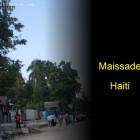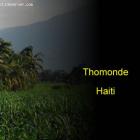ADVERTISEMENT
Coffee - Haiti Observer Blog
Coffee, Haiti Observer Blog. Read the following articles about Coffee
Paul Magloire, Haiti's 35th president
Paul Magloire, Haiti's 35th president, was born in 1907, heir of a military father. He followed his father's career path, enlisting in the army and rising to Chief of Police in Port-au-Prince.
Paul Magloire played a pivotal role in overthrowing two Haitian presidents, Élie Lescot and his successor, Dumarsais Estimé. President Estimé, in a fruitless effort to draw out his time in office, attempted to amend the Constitution. The mulatto elite aided Magloire in deposing Estimé. Magloire then took the reins of power as President of Haiti.
During his term, Paul Magloire poured money into tourism, Haiti becoming known as a desirable vacation destination for foreign travelers. Imposing a tax on coffee-bean exports, he used the monies for development projects, raising living standards of the impoverished, as well as improving city services. Most notably, he gave the right-to-vote to women. In foreign policy, he forged stronger relations with the Dominican Republic, reversing the violent and unstable history they had shared in the past.
Coteaux and the Miraculous Virgin
The town of Coteaux is the capital of the Arrondisement of Coteaux in Haiti's Sud Department. However, it is not the only reason why many people throng to the town every now and then. A high number of believers often go to the town in order to pray to the Miraculous Virgin in Coteaux.
It is believed that the Virgin hears and grants the prayers of believers, especially women. In order to reach the shrine where the Miraculous Virgin can be found, people have to pay a pilgrimage and climb a 500-step stair. Going to the shrine through the long stair is almost the same as scaling the popular Great Wall of China.
Thiotte offers best Haitian Coffee
Residents in the town of Thiotte in the Arrondissement of Belle-Ense heavily rely on the town's booming coffee industry. Many residents here are coffee farmers who get support from an organization called Root Capital. Under its small-business model program COOPCAB, rural farmers work together in order to increase and ensure the quality production of coffee beans. Coffee farmers in Thiotte grow Arabica beans.
Rural farmers also receive around 100,000 coffee and tree seedings from COOPCAB and this supply allows them to maintain production. Not only that, COOPCAB also encourages Thiotte farmers to follow sustainable farming practices so that the production of coffee in the town remains strong and steady.
Sainte Suzanne, A Destination in Haiti
Sainte-Suzanne is located in Haiti's Nord-Est Deparment which is municipality in the Trou-du-Nord Arrondissement. Sainte-Suzanne spreads over an area of 122km. Around 25,596 people inhabit the place. Chop, Blanc, Sarazin, Mocha-Nine, Fuller and Fond Bleu are the six communal sections comprising Saint-Suzanne.
Occupation and religion
Subsistence farming is the main occupation practiced by the people of Sainte-Susanne. Lime, coffer and orange trees are grown. To generate income, live stock is reared by some of the farmers in Saint Suzanne. Many of the people living in Sainte Suzanne are Catholics and practice Voodoo. Protestants also live there but are a minority.
Beautiful La Victoire Town In Haiti
La Victoire is located in Haiti's Nord Department at an altitude of 1417 above the level of the sea. In the Saint-Raphael Arrondissement, it is a municipality. It is inhabited by around 6421 people.
Getting To This Beautiful Destination
This is a mountainous region in Haiti. The town is beautifully surrounded by hills and steep valleys. Small rivers and streams flow at the bottom of these valleys. Port-au-Prince, Haiti's capital was destroyed in the 2010 earthquake and people in significant numbers fled to La Victoire town taking a toll on its scarce resources.
Mont Organise, Friendly Trade Partner of Dominican Republic
Mont Organise, part of the Ouanaminthe Arrondissement, under the Nord Est Department, lies very close to the Dominican Republic border in the north-east area of Haiti. Two sub-divisions comprise it, Wood Lice and Savanette.
Mont Organise's economy relies on trade activities conducted with the Dominican Republic (DR), whose borders are nearby. Not all trade is legal between the two countries. Smuggling operations exist, and both governments look the other way. Conflict between Haiti and the DR has had an intermittent history, but in some areas they show tolerance. One of them is the smuggling trade.
Livelihood In the town of Carice, Haiti
Thousands of people live in Carice, a remote town located in the Vallieres arrondissement in Haiti. According to statistics, the town has about 12,000 residents. Carice is a rural area without as many sources of livelihood as in cities and industrialized towns. This is why people rely on agriculture for their main livelihood. Farmers in the town mostly harvest mangoes, bananas and coffee, which are considered the main and most popular products in the area.
Though agriculture is the main source of livelihood in the town, deforestation is still common. As a matter of fact, deforestation affected the soil quality in the town. Despite this, however, the production of crops remains and continues to support people's livelihood.
The Town of Cornillon and its environment
There are many things and factors that contribute to the current condition in Cornillon, a small town in the Arrondissement of Croix-des-Bouquets. It is not a super rich town but its people still have a decent source of livelihood. To know more about the town in the Department of Ouest, here are some more information about it.
Situated in a mountainous region of the southern eastern part of the country, Cornillon has more than 48,900 inhabitants. The town comprises of five sections and witnesses tropical wet and dry weathers.
The town has experienced wide deforestation. This is because settlements were needed. Deforestation was also done in order to give way for more charcoal production. Such production is one of the main sources of income in the town because the demand for coal is high across the country. Because charcoal is the primary source of fuel in Haiti, charcoal product has become one of the highest income-generating livelihoods, especially in Cornillon. However, people do not only rely on charcoal production to make ends meet. They also produce fruits and coffee. Without agricultural and charcoal productions, residents will probably find it more difficult to get by as the town is not as wealthy as the other cities in the country.
Mombin-Crochu and Living condition
Many people in the town of Mombin-Crochu in the Vallieres Arrondissement live in poverty. Residents do not have the luxury of living a very comfortable life, as Mombin-Crochu is one of the poor towns in the country. In fact, children are forced to walk barefoot because they do not have money to buy slippers. They also walk just to go to school because only a few have access to donkeys, which are the main transportation in the town.
When it comes to utilities, residents in Mombin-Crochu have to go by without a regular supply of water and electricity because they could not afford it. In order to make fuel and cook, they use charcoal and wood fire.
Port-Margot, known for numerous rivers
The town of Borgne's other half in the Borgne Arrondissement located in the Nord Department is the municipality of Port-Margot. It is known for its numerous rivers, beautiful beaches, and mountainous geography. The municipality is composed of six sections, namely Bas-Petit, Bas-Quartier, Bras Gauche, Borgne Corail, Grande Plaine, and Haut Petit.
Port-Margot is home to about 37,000 Haitians who are mostly of Protestant faith. Most of them live a simple life, relying heavily on the municipality's many rivers for their livelihood. Rich vegetation is the most beneficial use of the rivers of Port-Margot, resulting to the heavy production cocoa and coffee. Historically, the municipality was Saint Dominque first French settlement. It is composed of several elementary schools and high schools, as well as a few health centres.
Our objective is to share with you news and information about Haiti and the people of Haiti. Traditions, habits and the way we were or grew are alive in this site. We highly recommend that you Subscribe to our Newsletter and also share with us some of the things that are memorable and made us unique people.

 Informative Marketing and Advertising in the Haitian Community
Informative Marketing and Advertising in the Haitian Community  Maissade, Haiti
Maissade, Haiti  Thomonde, Haiti
Thomonde, Haiti  Life After Death
Life After Death  Newsletter
Newsletter